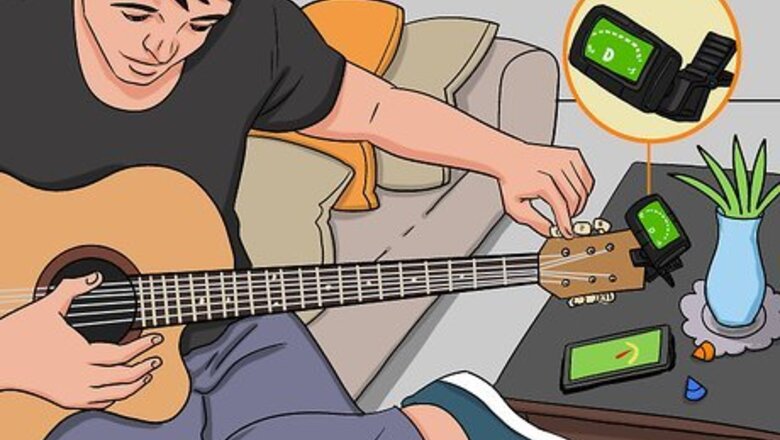
views
Making Basic Adjustments

Check your intonation using a chromatic tuner. A chromatic tuner provides an electronic readout of the exact note that each string is playing. If your intonation is correct, the tone produced when you fret the 12th fret and pluck the string should be the same tone exactly one octave higher than the open string. You can buy a chromatic tuner at any guitar store relatively cheaply, if you don't already have one. There also are a number of mobile phone apps that offer a chromatic tuner, although these may not be as exact as a physical tuner. Any guitar bought off the shelf, no matter how expensive, may have intonation problems. If possible, run this check before you buy a new guitar.
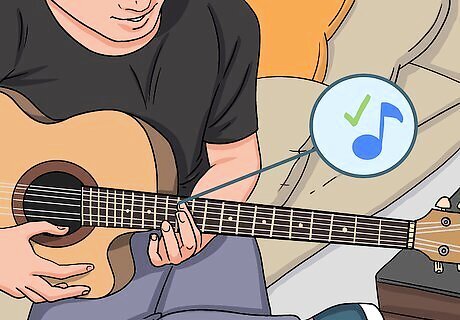
Learn more precise tuning methods. Different tuning methods may enable you to correct intonation problems without changing the set-up of your guitar. You might try using harmonics to tune the guitar to itself. When the strings are tuned, fret each string at the 12th fret. It should produce a sound exactly one octave higher than the pitch at the open string. If the pitch is off, your intonation is off.
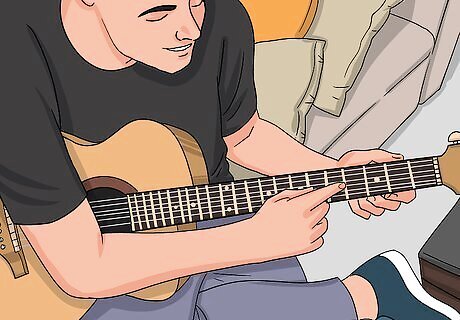
Examine your frets. If your frets are worn down or dirty, this could cause your guitar to have intonation problems. If the crown of a fret is flat, or if it has grooves in it, the string length will be affected, which can change the pitch of the note played. If you notice any worn or damaged frets, take your guitar to a luthier for repair. Do not attempt to replace the frets yourself unless you have experience doing so, as you could permanently damage your guitar.
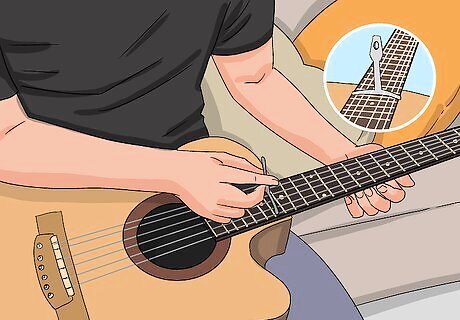
Adjust your string quality and gauge. The strings you're using affect the quality of sound your guitar produces. Old or poor-quality strings can ruin your guitar's intonation. If you put strings of a heavier gauge on your guitar, that also can damage the guitar's tone. Check the materials that came with your guitar or talk to an experienced luthier to determine the correct gauge of strings for your guitar. When you buy a new set of strings, check the actual gauge carefully. Different brands have different categories and systems of organization, so one brand of "light" strings won't necessarily be the same gauge as other "light" strings.
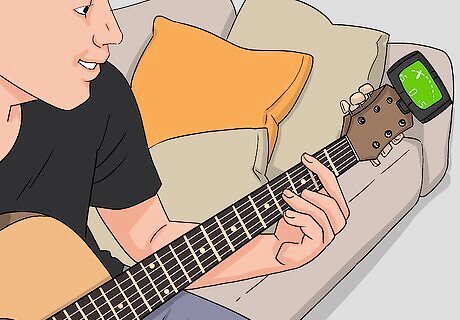
Evaluate your playing technique. If you have a powerful fretting technique, you may be putting excessive pressure on the strings. This can cause your guitar to play sharp, especially if you have relatively tall frets. Vary your finger pressure as you play notes on your guitar. Use a chromatic tuner to see how your finger pressure directly affects the tone. You may be able to correct your intonation problem simply by varying your fretting technique.
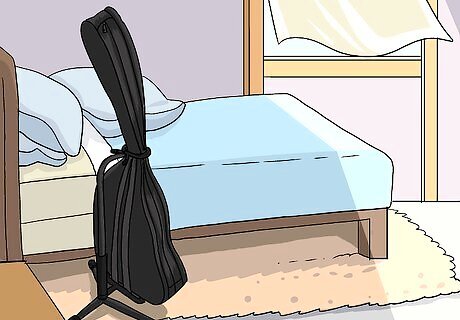
Prevent intonation problems by storing your guitar properly. Your guitar should be stored away from sunlight and heat, in an area with between 40 and 60 percent humidity. Too much humidity can cause your guitar to warp, leading to intonation problems. When you're not playing your guitar, keep it in its case. A hard case is ideal, but even a good quality soft-sided gig bag is better than simply leaving it out exposed to the elements. To check if your guitar has been warped by lack of humidity in a way that could affect its intonation, lay your guitar on a table and set a ruler across the top of it. You should be able to see light between the edges of the guitar and the ruler on either side.
Compensating at the Neck

Sight the neck of your guitar. Hold your guitar up at eye level and gaze down the neck. Look for signs of warpage or other issues that could be affecting your guitar's intonation. When you look down the neck of your guitar, it should be perfectly straight. If you see any cracks or separation at the neck joint, or notice any warping along the width of the neck, take your guitar to an experienced luthier. This repair requires work beyond simple adjustments.
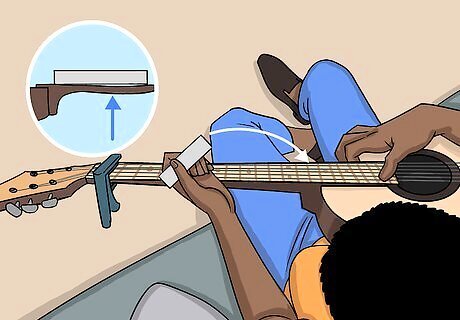
Evaluate neck relief. Your guitar's "neck relief" is the amount it curves along its length. Too much neck relief can cause problems with intonation because it means that your strings are further away from the neck at some frets than at others. You can make minor adjustments to correct neck relief by tightening or loosening the truss rod. This is something that you can do at home, but if you feel at all uncomfortable doing it, go ahead and take it to a luthier. If your neck is curved to the point of being bowed, you risk breaking it if you adjust the truss rod. Take it to an experienced luthier for an assessment.
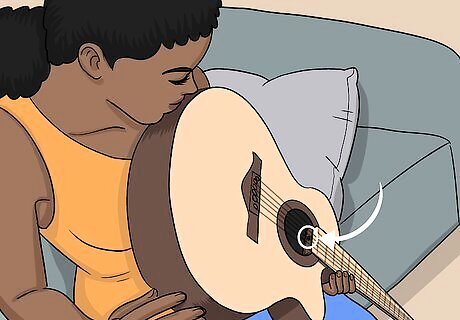
Adjust the truss rod. Your guitar has a truss rod, accessible either through the sound hole of your guitar or behind a panel just above the nut. The rod can be adjusted either with a regular Allen wrench or a socket wrench. Turn the rod to the left to loosen it, or to the right to tighten it. Go extremely slowly, and only turn it a maximum of a quarter-inch (about 6 millimeters) at a time. Never turn it more than a complete turn. Loosening will add relief (greater distance between the string and the neck), while tightening the truss rod takes away relief.
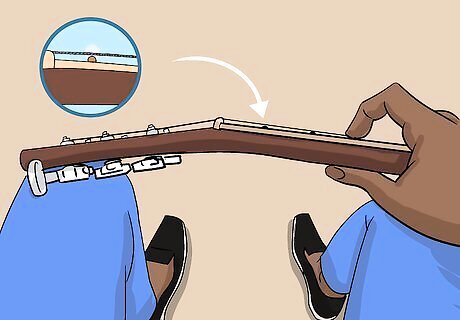
Check action at the nut. The action is the space between the strings and the frets. A lot of action will make the strings more difficult to press down, and can affect your guitar's intonation. Not enough action and the strings will buzz, damaging your sound quality. Hold the neck of your guitar at eye level. One at a time, press down each string between the second and third frets and look at the clearance of the string over the first fret. If you can see just a sliver of light between the string and the first fret, that tells you that the strings are sitting correctly in the nut. If there's too much space, the intonation will be off. You can fix this by filing down the string slots just a little so that the string sits lower. If there's no space between the first fret and the string, this is going to cause the string to buzz against the first fret when you strum the open string, which can also affect the sound of your guitar. You can fix this by raising the nut so the string sits higher.
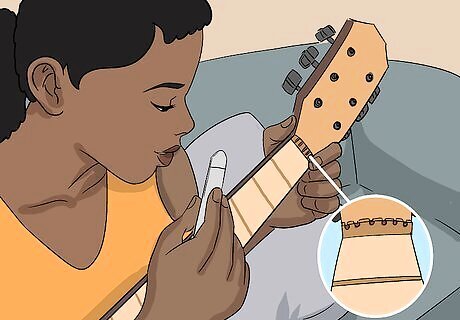
Try to file or raise the nut yourself. If you noticed that you had too much action at the nut, you can file the string slots yourself if you have the right tools. You'll need a nut file to get the slot in the right shape. Otherwise, take your guitar to a luthier. You also can replace the nut with a higher nut, or get the replacement done at a music shop. Don't glue a similar piece of material to the bottom of the nut to increase its thickness, since this can damage your guitar. When raising your nut, start with the smallest sliver – if you raise your nut too high you could adversely affect the tone of your instrument. Keep the same thing in mind when filing the string slots – once the nut is filed away, you can't put it back.
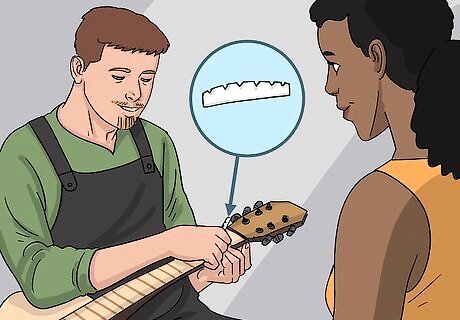
Install a prefabricated compensated nut instead of filing the nut yourself. Swapping out your old nut with a prefabricated nut that will correct the action may be the easiest thing for you to do. Prefabricated nuts aren't too expensive, and you don't run the risk of ruining the original nut. You can find prefabricated compensated nuts at your local guitar shop, or you can order one online. Make sure the nut you choose is designed to fit on your guitar. If you have trouble installing it yourself or find you don't have the right tools to do it correctly, take your guitar to a luthier. Installing a prefabricated compensated nut also may remedy intonation problems that were caused either by the shape of your nut, or the shapes of the string slots.
Adjusting the Saddle
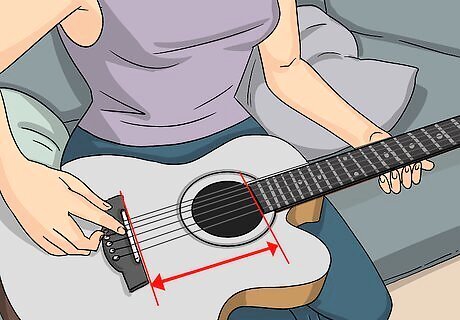
Check saddle height. If the strings are too close to the fingerboard, your guitar will have a sharp intonation. If your guitar plays with a flat intonation, it could be because the saddle is set too low. You can't change the placement of the saddle yourself. If it seems your guitar's intonation problems are caused by the placement of the saddle, take your guitar to a luthier and explain your concerns.
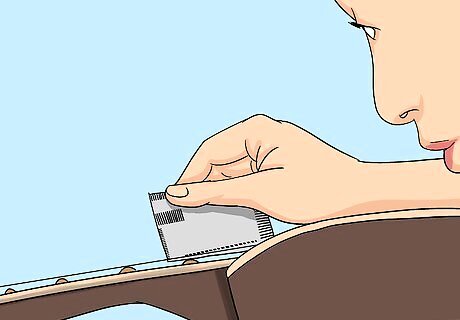
Measure string height. To determine if the saddle is at the correct height, you need to measure the distance between your strings and the 12th fret. The "correct" distance between your strings and the 12th fret will vary depending on your playing style, the type of strings you use, and your individual guitar. You can search online to find 12th fret clearances depending on different playing styles and different types of strings. Look for websites for luthiers, guitar or string manufacturers. Another method of measuring string height is to put a capo above the first fret and measure string distance from the 13th fret. This will result in a slightly lower height, so whichever method you choose, make sure you use it consistently.

Install a pre-made compensated saddle. If you need to raise the saddle, buying a pre-made compensated saddle usually is easier than attempting to compensate the saddle that came with the guitar. These compensated saddles typically cost between $5 and $100, depending on the material. If you can find a compensated saddle that fits your guitar and raises the strings to the height you need, you have an easy option to adjust your guitar's intonation. The pre-made saddle will end up being cheaper than a professional repair.

Sand down the saddle from the bottom. If the saddle is too high, it is possible to sand it down so that the strings sit lower. This may correct your intonation problem. Work slowly and incrementally with sandpaper, taking care not to sand down too much. Make sure you are sanding the saddle evenly, or you could make your intonation problem worse. It may help to draw a line on the side of your saddle with a pencil and then sand down to the line. Don't try to adjust the saddle yourself if your acoustic guitar has a pickup under the saddle. Pickups are precisely positioned and fragile.




















Comments
0 comment